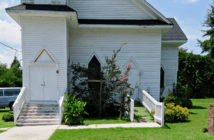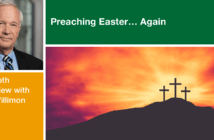Bill Wilson shares 11 provocative thoughts and questions regarding how the future of the church will be shaped by the implications of the cornonavirus pandemic. He says this crisis catapulted the church forward and we cannot ignore the lessons learned.
What’s on the horizon for congregations and parishes as we transition from the crisis of the moment to the long-term implications of the coronavirus pandemic? Here are 11 thoughts and questions we all need to ponder.
1. Expect no light switch moment.
There will be no light switch moment when some horn sounds and life suddenly returns to normal for churches and parishes. Instead, we will gradually and painfully emerge from this pandemic and its impact over the course of months and even years. Until there is a reliable vaccination for the virus (estimated to be 12-24 months), we should assume that many people would be wary of public gatherings of any type. It will probably be well into 2021 before large-scale physical worship attendance becomes the norm.
2. Adaptive change is the new reality.
This means that the adaptive change lessons we have learned over the last five weeks are our new reality. Specifically, innovative methods for gathering the scattered church, engaging the dechurched, and meeting the unchurched and our neighbors are going to be our primary focus for the rest of this year and probably longer. We are going to need some new metrics, by the way.
3. Churches have proven themselves imaginative and resilient.
We have learned so much so quickly! We discovered that we can connect with a wider range of church members than we thought possible, provided we are willing to go to them on a regular basis and in multiple formats via the internet. If we have learned this much in five weeks, what will be know five months from now? Our resilience and imagination are encouraging.
4. Virtual worship holds creative new possibilities.
We have learned that we can quickly develop online content at low cost and in sufficient quality. Already, the notion that online worship must be a replica of sanctuary worship is fading. It is remarkable to watch the adaptation that is taking place as people begin to explore the possibilities and creativity of virtual worship.
5. Meaningful connections occur even when physically distant.
We have learned that we have people who are willing to connect with socially isolated members by phone, email, Facebook, Zoom, and other means. We can have meaningful ongoing contact even if we cannot be physically present with one another. The next generation of this contact will be fascinating to watch as we find new ways to create deep connections with one another.
6. Mental health concerns will likely spike.
We should assume a surge of mental illnesses, increased addictions, depression, loneliness, marital conflict, parenting frustrations, chronic anxiety, unresolved grief, etc. How are we preparing to offer help to those who are going to suffer most as the disruption continues?
7. Reliance on the internet is here to stay.
When we do get back to whatever passes for normal, we will have a whole culture even more addicted to the internet than previously. How will this impact the way we engage our church and/or fellow believers? We should not expect our folks to walk away from what has become indispensible to them.
8. Does staying connected with new virtual constituencies require a realignment of priorities?
It has been our observation that, prior to the virus, most church staff members invested nearly all of their time in people who showed up for church on a regular basis. In the future church, will staff revert to such a pattern, or will they reconfigure their time to include preparing and using the internet to stay in touch with the moderately and slightly connected members of the church and even the largely disconnected? If staff members decide to reconfigure their use of time, what might that look like and how will it be received by relevant oversight groups?
9. Will we cultivate a congregation among those not physically present?
Will congregations and ministers be willing to try to cultivate a congregation outside the core congregation, one that exists primarily via individual interactions with online content and communications rather than physical presence at designated times?
10. How will online groups impact the future?
Will ministers and the congregation be willing to build on their experience with Zoom and other providers in order to structure, promote, and resource online small groups? If so, what might be the impact of such an effort on former methodologies and on a church’s reach and influence?
11. Is our building necessary for delivering our ministry?
Finally, churches are being challenged to have the same conversations as retailers, universities, and hospitals: Is our building a necessity for delivering our services/ministry? We will probably learn to answer this as a polarity exercise. That is, the answer will simultaneously be “yes” and “no.” Like retailers, universities and hospitals, we will find ways to be the church both in a physical location AND in a virtual and scattered manner. We knew this diversification was needed, but the pandemic has fast-forwarded us into our future at warp speed. We will not be able to unlearn what we have learned about being the church going forward. Our new normal will see us regarding our physical location as one of many expressions of our church. In doing so, we will quite possibly become more of the gathered and scattered church Jesus had in mind for his followers.
This article was adapted from a post entitled “What Now?” on the website of The Center for Healthy Churches. Used by permission. Mike Smith, recently retired pastor at Central Baptist Church, Fountain City, Tennessee, contributed to this article.
RELATED RESOURCES
- Digital Church is Here to Stay by Carey Nieuwhof
- Becoming a Church Without Walls by Andrew Ponder Williams






